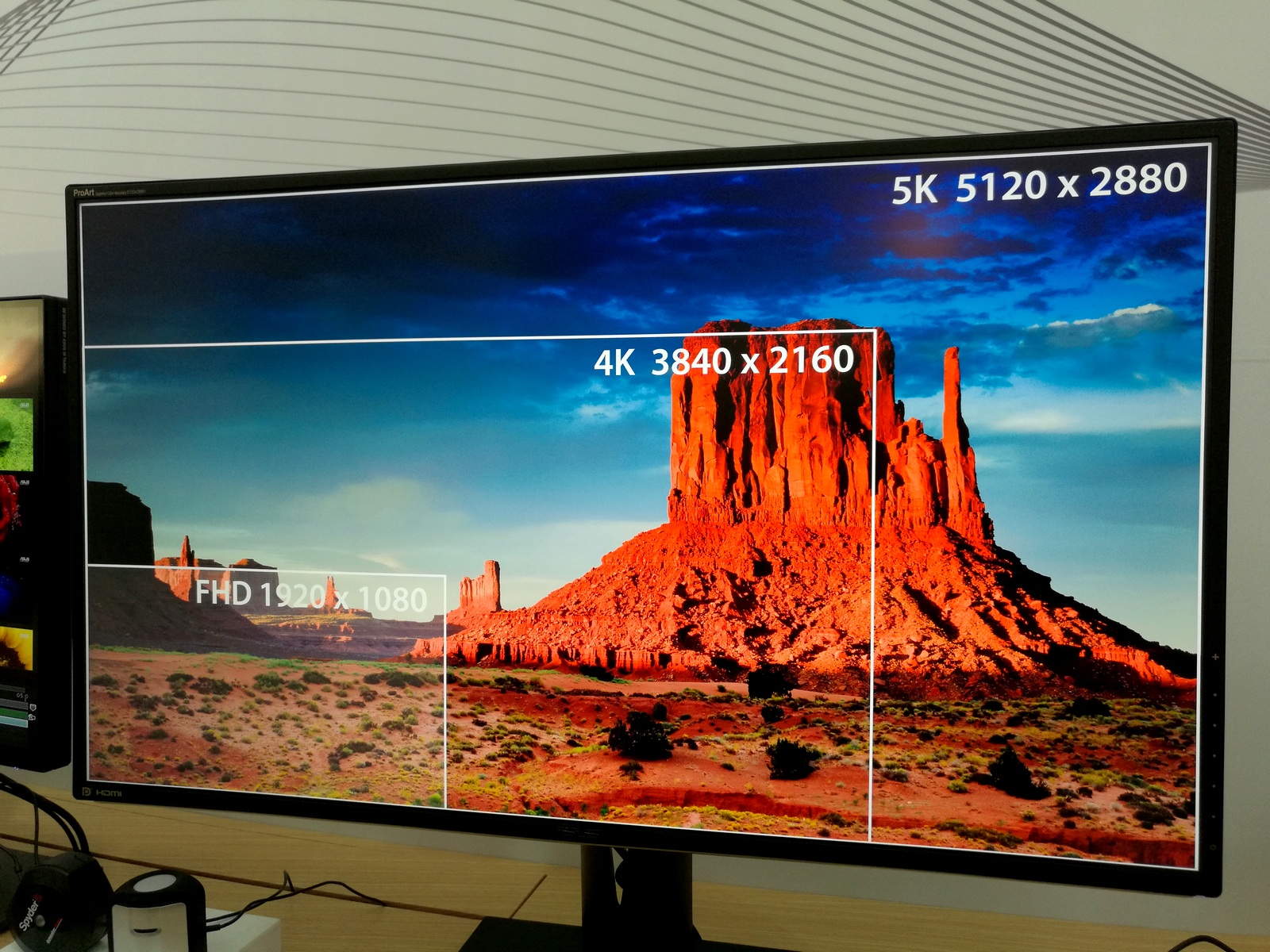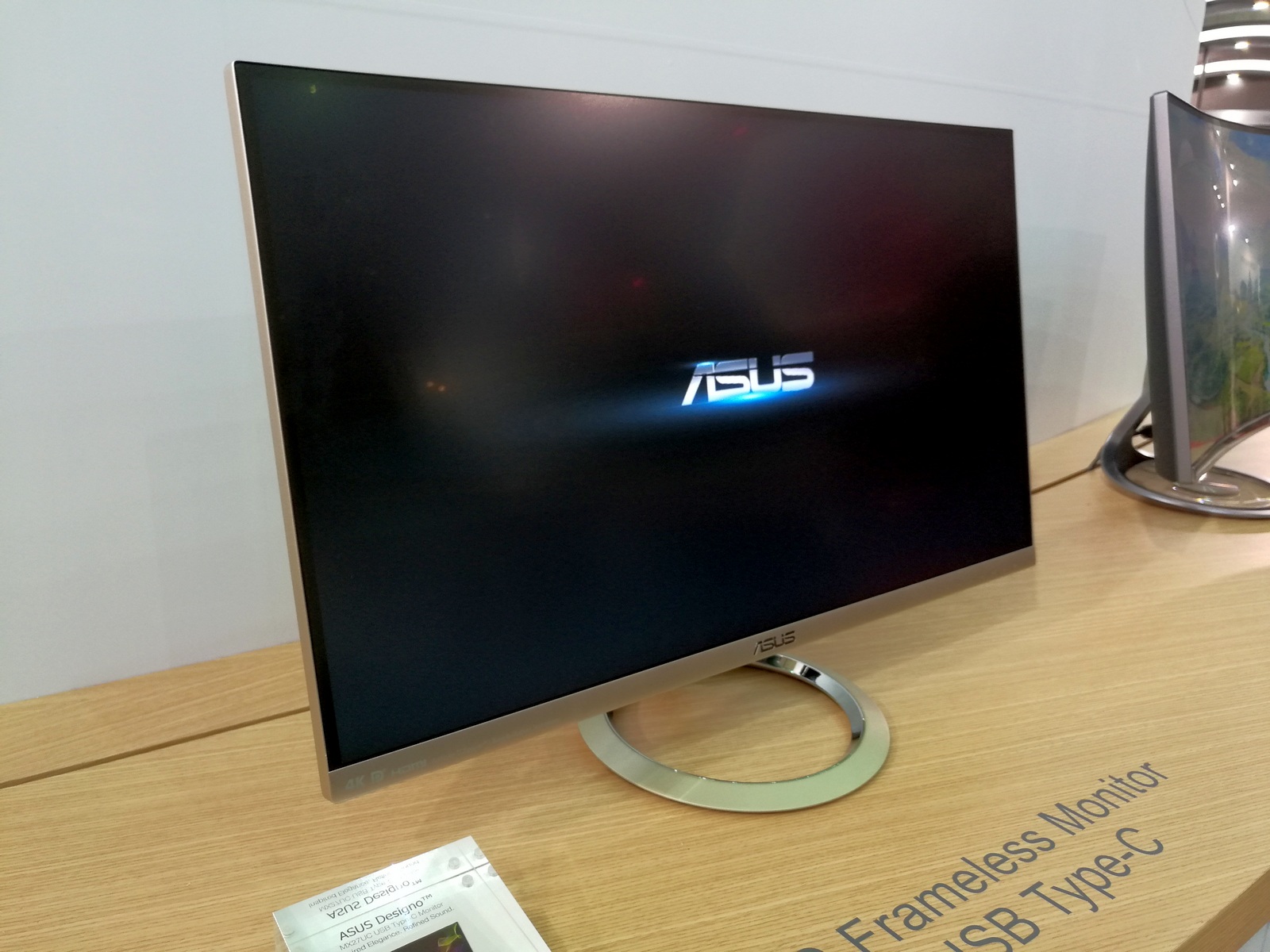ASUS at Computex 2016: The 10 Years of the Republic Of Gamers (ROG) Booth Tour
by Ian Cutress on June 22, 2016 8:00 AM ESTAnyone remember when 32-inch 4K monitors were $3500? We reviewed ASUS’ PQ321Q back in July 2013, and since then every monitor manufacturer under the sun has some 4K variant, or in some cases, a wide variety of high-performance, high-quality panels broaching professional status and all at a seemingly cheaper price than what we saw only three years ago. Case in point, my three Dell UP2415Q monitors I purchased in 2015 were under $500 each (it was either that or buy a DSLR; the monitors won). But now that 4K is slowly moving down the chain into the mainstream, even with ultra-wide 21:9 monitors in tow for gaming, the next barrier is 5K.
5K monitors, using a 5120x2880 resolution, comes in at twice the 2560x1440 (colloquially ‘25x16’) panels we saw flood the market around the same time that 4K was starting to take hold. Of course, pushing 3.7 million pixels on a 25x16 panel back then was tough, but now going for almost 15 million pixels on the new 5K standard is somewhat insane. Luckily 14nm/16nm GPUs are being released this year…!
Apple’s 5K iMac has been the first serious attempt at a 5K display, attaching a custom TCON arrangement to a 27-inch panel. The minimum price for this is $1800, but that includes the rest of the iMac: a quad-core Intel Core i5 processor with Iris Pro graphics, 8GB of memory, a 1TB mechanical drive, and an AMD R9 M380 high-end mobile graphics card. Dell’s 5K panel, the UP2715K, can be used on any monitor with dual DisplayPort in MST mode. Luckily MST modes are more mature than when they first appeared on 4K, and from what is online, the 5K MST mode is more manageable than it was back in 2013.
The ASUS ProArt
So enter ASUS into the 5K market, with the ASUS 32-inch 5K ProArt display.
The ProArt name and lack of an official SKU number suggests both that ASUS is aiming for the professional market first and that the device is still being finalized.
With the display, ASUS is quoting 100% Rec.709, 99.5% AdobeRGB and 95% DCI-P3 in terms of color reproduction, as well as bundling the display with ASUS’ ProArt calibration tools. The display will support DisplayPort 1.3, which suggests that only a single cable should be needed to run at 60Hz when using 24-bit color. Given that this is a professional display, I would assume that increasing the color bit-depth to 10-bit would require a reduction in refresh rate to compensate.
Connectivity on the rear includes HDMI 2.0, DisplayPort 1.3, five USB 3.0 ports (a hub) and a 9-in-1 card reader.
DisplayPort over Type-C: The ASUS 4K Designo MX27UC
The march towards Type-C acceptance is strong, and one of the poignant benefits of Type-C is meant to be that in the right circumstances, it will support video. We’ve seen Apple’s Thunderbolt display do something similar in the past using Thunderbolt, but in this case the new ASUS Designo MX27UC uses the USB 3.1 Type-C port with power delivery, DisplayPort alternate mode and data transmission modes.
Rather than a professional display, ASUS is butting this into a premium look product. The MX27UC will have a 3840x2160 (‘4K’/UHD) resolution, a brushed metal ‘frameless’ design and Bang&Olufsen speaker technology. It is worth noting that while frameless, it isn’t actually borderless, with a good 5-7mm around the display being required around the edges.














43 Comments
View All Comments
A5 - Wednesday, June 22, 2016 - link
End users who are buying Broadwell-E are almost always doing it for 3+ way SLI reasons, which pretty much forces you into full ATX.They presumably have research (or data from the past) that says they will not sell enough mATX boards with HEDT chipsets to be worth the engineering effort.
Bragabondio - Wednesday, June 22, 2016 - link
Well now that Nvidia would not support more than 2 cards SLI (except for benchmarking applications) the argument for 3 way SLI becomes moot. (micro ATX supports 2 way SLI). Starting to think we will be stuck with 4 core CPUs for the next 5+ years unless ZEN is a huge success.Sushisamurai - Wednesday, June 22, 2016 - link
uhhh... Nvidia still has 3 way/4 way SLI - they've only restricted SLI requirements to PCIe x8, versus AMD's crossfire x4; presumably to maintain a performance target. With "consumer" lines of Intel CPU's, you only get max 20 PCIe lanes (correct me if I'm wrong), allowing only 2 way SLI. HEDT chips have 28 to 40 to 40. Hence, 3 way to 4 way SLI is pretty much restricted purely to HEDT. Anandtech had an article about CPU/PCIe bottleneck with SLI/CF a ?few years back. If memory serves me correctly, PCIe x4 bottlenecks modern high end GPU's, and an i5 can run 2 high end GPU's without bottlenecking - it is when you go 3 cards you'll need an i7 for gaming (assuming you have enough lanes), and HEDT (my opinion now) if you want 4 cards (due to PCIe lanes, and enough cores to feed the cards)Bragabondio - Wednesday, June 22, 2016 - link
Correct until GTX 1070&1080 were introduced. Starting with the GeForce GTX 1080, Nvidia is discontinuing official support for 3-way and 4-way multi-GPU SLI setups.http://www.pcworld.com/article/3071332/hardware/it...
Sushisamurai - Thursday, June 23, 2016 - link
Oh that is messed up. I've read their white paper, didn't even know they trashed the enthusiast key option. Wow that's super unfortunate.alphasquadron - Wednesday, June 22, 2016 - link
"So I don't understand why manufacturers don't want my money?"I think they do but as stated in the article:
"The three major form factors for custom build personal computers, in order of popularity, are ATX, followed by micro-ATX and then mini-ITX."
I too am waiting for an external dock that I can plug my laptop into and achieve 80-90% of performance of a full size desktop. Whoever makes this will have grabbed two markets. Those who want a gaming desktop and are okay with huge cases (usually younger) and professionals like me who want the same but would never get a gigantic case. If we can get an external dock that tries to be compatible with most laptops as much as possible without looking like an eyesore and can deliver close to desktop performance, it would be an instant buy for a lot of people. As you now have a laptop and desktop. Though I think that this would come from a laptop manufacturer as if it was very well made and successful, I would think the market that would buy a desktop over a laptop for 10% gain in performance would be very small.
Bragabondio - Wednesday, June 22, 2016 - link
Guess I have to give my dream for small but super powerful desktop PC and embrace the reality that laptop/surface device + dock is the future for the middle aged professional :)Bragabondio - Wednesday, June 22, 2016 - link
One more thing. The ATX may be indeed most popular size but that is mostly due to tradition not function as 99% of the consumer market don't need/use all the slots and space of a larger ATX case. That is why I like project Avalon but nobody knows if it ever would become a reality.Ananke - Wednesday, June 22, 2016 - link
Unfortunately, in the current moment of the high tech industry, "middle age" is very inappropriate. Companies think their teen- and twenty-year old customers have many thousands of disposable income , and cater to them exclusively. Besides, young people buy easily obsolete or inferior tech, since they don't have comparison base :):). The only problem for the tech industry is, that younger population usually has no disposable income /and that's kinda universal truth over many centuries/ and just doesn't buy because it can't pay.Bragabondio - Wednesday, June 22, 2016 - link
well said Ananke! Plus, as a coup de grace now we have to deal with gazillion of RGB lights inside our cases - if I wanted a freaking X-mas tree inside my case I would have bought one ! :)